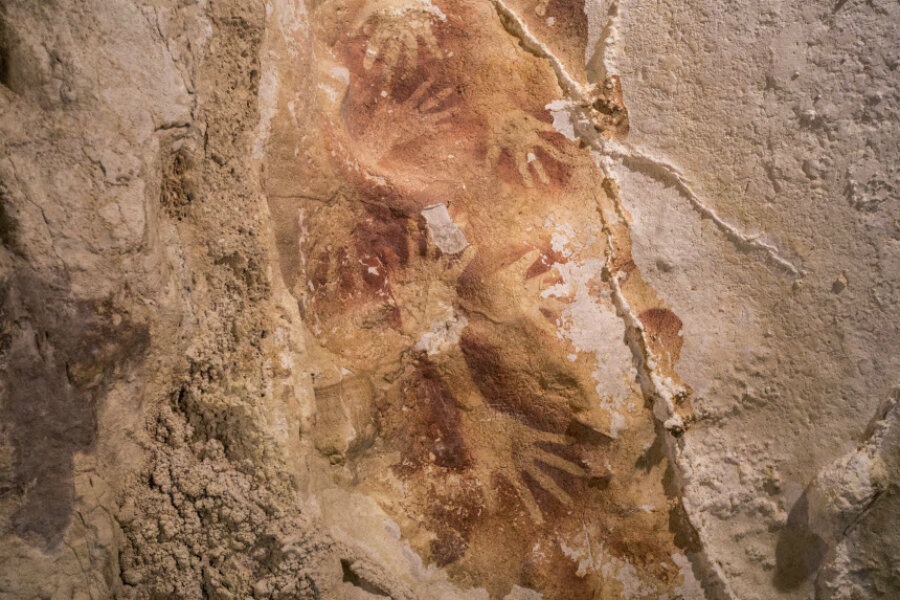Indonesian cave art: oldest hand 'stencil' yet discovered
Loading...
For years, Europe has boasted the oldest examples of prehistoric cave art – a testament to the arrival of anatomically modern humans some 45,000 years ago, their budding creativity, and their ability to think symbolically.
Southeast Asia may give Europe a run for its money. For the first time, researchers have applied high-tech dating techniques to prehistoric art on the walls of seven limestone caves near the town of Maros on the Indonesian island of Sulawesi. The hand "stencils" and animal images that adorn the walls have minimum ages ranging from 35,400 to 39,900 years old. This falls within the range of dates assigned to the oldest cave art in Europe.
The oldest of the Indonesian hand stencils – the outline of a hand surrounded by red ocher – is the oldest known hand stencil yet found, according to a team of Indonesian and Australian scientists reporting the analysis in Thursday's issue of the journal Nature.
The area has long been known for its abundance of caves sporting ancient rock art, notes Wil Roebroeks, an archaeologist at the University of Leiden in the Netherlands, in an e-mail.
The abundance of cave art "by itself is a very rare phenomenon," explains Dr. Roebroeks, who didn't take part in the study. "This study now shows that part of this art is amongst the first art made anywhere in the world."
The ages raise intriguing questions, notes the research team conducting the study, led by archaeologists Maxime Aubert, with Griffith University in Queensland, and Adam Brumm, with the University of Woolongong in New South Wales.
The dates "suggest that figurative art was already part of the cultural repertoire" of the first modern humans to reach the region more than 40,000 years ago, they write.
One way to explain an itch to draw on cave walls among populations 8,000 miles apart is that the trait emerged in both groups independently – a kind of parallel cultural or cognitive development.
The alternative: The Asian and European groups carried a shared artistic tradition in different geographic directions. Their penchant for producing rock art emerged much earlier as modern humans left Africa, perhaps as early as 125,000 years ago. That would suggest additional discoveries may crop up along the migration routes these immigrants took.
Researchers have been studying the cave art near Maros since the the 1950s, notes Dr. Aubert in an e-mail. Indeed, the limestone hills, or karsts, in the area have been cited as possible additions to the United Nations Education, Cultural, and Scientific Organization's list of World Heritage Sites.
But the rates of rainy-season erosion led some people to conclude that the cave art was no older than about 8,000 years. "No one had tried to date it previously," Aubert writes, in no small part because Indonesian scientists, who have been keenly interested in the age question, didn't have the resources to do the job.
Thank "cave popcorn" for kindling new interest in figuring out how old the cave art is.
During field work at the caves in 2011, Dr. Brumm noticed that tiny nodules resembling cauliflower covered some of the hand stencils. These nodules were tiny mineral deposits that built up layer by layer as mineral-laded water percolated through the limestone during the rainy season, formed a thin film on the cave wall, then evaporated.
Naturally occurring uranium was among the elements present in the layers. As it decays, uranium-234 morphs into thorium-230. By comparing the ratio of the two isotopes in carefully extracted samples from successive popcorn layers, the team could estimate the minimum ages of the art.
The region's verdant limestone hills, rich in biodiversity as well as in evidence of prehistoric human activity, are "under severe threat from cement, marble, and phosphate mining, which threatens to quarry away large parts of this area," Roebroeks notes.
It remains to be seen if the new dates for the rock art at Maros help efforts to preserve the karsts and their record of prehistoric human activity as a World Heritage Site, designations given to several cave-art sites in Europe.
In the meantime, Aubert and colleagues are now working to find and date rock art on Borneo and New Guinea.








